1 SAI - Ratels in Op Hooper (1987-1988)
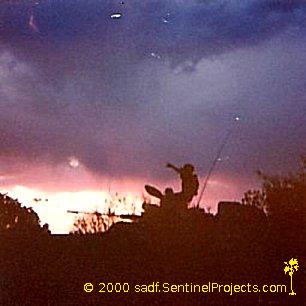
I was born and grew up in Cape Town. I went to school at Muizenberg High School, next to the sea, so when it was time to be called-up (1987) I was really hoping that I would get a Navy call-up. When we got our call-up papers I was really disappointed - 1SAI!! The next day at school everyone was asking each other where they got called-up. A lot of the guys got really cushy posts - Navy, Anti Aircraft (Youngsfield) etc. Some of us got Infantry, but only another guy, Mark Stanley, and myself got 1SAI.
I was not happy about this because this was the same unit that my brother had been in and he had had a tough time. He served at 1SAI and 61 Mech. in 1979/1980 and was badly injured during Operation Smokeshell. He was one of only four to survive out of his Ratel - the victim of ZSU23mm Anti Aircraft cannon. I remember the day that we heard he had been injured - I was only about 11 years old and wasn't told much about it - I still don't know too much about it, as it is not something that he talks about today. I remember going to 2 Military hospital and visiting him - he was in a pretty bad way. Shrapnel riddled his one leg - when he was recovering, he was walking on Muizenberg beach and someone asked him if a shark had attacked him! So you could understand my reluctance about going to 1SAI. All I could think of was "My poor mother, she has already been through it all with one son!"
Anyway, there was no getting out of it, I wasn't going to University, and I had no money to dodge the country so I was resigned to go. I was fairly fit, if a slight bit overweight, but I didn't do anything to try and get fit before I went - that was their job! My last few days were spent painting my folks house and spending time with my then girlfriend - her mother suggested that we get married, that way I would be posted closer to home - don't know if that would have worked?
My dad dropped me off at Wingfield in February 1987. I had been to Wingfield once before - I had done a Cadet Leadership course there a few years before, but now this was for real! They let parents and loved ones stay with us for a while and then the MP's (Military Police) came around and looked through everyone's bags for contraband. After that we were herded onto trains and started the long, slow trek to Bloemfontein. They left us pretty much alone on the train, which was good because it gave us a chance to make new friends along the way. Mark Stanley and I remained together on the train - we were to be together for the next 2 years. After a pretty non-eventful trip we arrived in Bloemfontein - this is where the fun started.
Outside Bloemfontein train station there were rows of SAMIL's (1) waiting for us. We were rushed aboard and driven to Tempe, the large military base that housed 1SAI, The Parachute Battalion, School of Armour and 3 Military Hospital. I heard later that one guy was being rushed onto a truck and smacked his knee so hard on the tailgate that his kneecap broke - immediate G5K5 (2) and out of the army.
The rest is a bit of a blur as it all happened so fast yet things progressed quite slowly. We were put into platoons and into bungalows. I was in Charlie Company, platoon 2. Our bungalows were the ones closest to the main gate. That evening we were sent to the stores to get our trommel (3) and bedding. We then had to carry it back to our bungalows, which I suppose were about half a kilometre away. That is when it really sank in - this was going to be hard work! I was never very physically strong and I found that long run/walk backbreaking. The next day we were issued with our uniform for the next few months - overalls, webbelt, boots, staaldak (4) and webbing. We were also (I think) the guinea pigs for the new "lightweight" canvass boots, which were very comfortable although we didn't get to wear them for a while.
BASICS
Medial Examination
Before basics started we were marched/ran out of the base to just outside 3 Military hospital and there we spent the rest of the day - waiting for our medical inspections. This was an awful process and quite embarrassing for a lot of the guys. You basically waited for your platoons turn, went into the hall, stripped naked and proceeded in a queue to see the doctor. He would then perform the age-old tradition of grabbing your testicles and making you cough. They also tested your eyes, hearing, colour-blindness (which if you were was a bonus as you were sent off to be trained as a camouflage spotter) checked for flat feet and finally a urine test. This final test proved to be something of a real test for me because try as I might, I could not urinate! I tried drinking water, listening to water running, thinking about it - but nothing! Eventually after about half an hour I managed to produce a specimen. I was getting so desperate that I was contemplating asking one of my new friends to do it for me! After this all the people that were fine were classified as G1K1, which meant that you were physically, and mentally fit. If something was wrong with you, you were classified G3K3 which meant that you were not suitable for full training and activity. If you were G5K5 (2) there was no hope for you and you were discharged.
Our Corporals in basics were Corporal Du Preez and Corporal Firmalter and our platoon officer was Lieutenant Reynecke. Looking back now I suppose that they were all right. All our instructors were National Servicemen and they had been trained very well. Basics consisted of getting up at about 5:00am, washing, dressing and going to the mess for breakfast. This was done in platoons - you marched up to the mess and then had to wait outside before you could go in and eat. Before being allowed inside someone had to say grace. This always turned into a bit of a lottery as we quickly learned that the person that said the prayers would get to eat first. So I think everyone volunteered at one stage or another. Meals were very rushed, as you didn't want to spend too long in the mess, as you had to get back to the bungalow for inspection at 7:00am. We were issued with a Varkpan (5), Pikstel (6) and plastic cup. We had to take the cup with us wherever we went for lessons as coffee or juice was served during tea breaks. I suppose the food wasn't that bad but was still bad enough. Usually breakfast consisted of porridge of some sort - usually runny white pap (7), fried eggs (made about three hours previously), meat (?) and bread with coffee. After you were finished eating you went outside to the basins and washed your pikstel (6) and cup and put your varkpan (5) into a huge industrial dishwasher and then picked up a clean one at the other side.
On certain mornings your platoon was expected to do "Camp Maintenance" which meant that you were to go out while it was still dark and sweep the roads, rake the gravel etc around your company's bungalows.
After breakfast we headed back to our bungalows to prepare for inspection. We were shown on our first night how to make a bed properly - hospital corners etc. The rest of the bed was made to standard army order - two stripes of the blanket in the middle of the bed, towel on the end of the bed and the two stripes simulated on the towel by means of a toothbrush combing the fibres of the towel in opposite directions. We soon learned what pleased our instructors. When rank walked into the bungalow, someone (normally the person closest to the door) would shout "Staan op!!" (Stand up!) At which point everyone would jump to attention. Failure to do this was a lack of "respect" and would earn everyone a "jaag" (8) around the bungalow. We caught on pretty quickly that what they were doing was trying to get everyone to work as a team. The most common admonition that we would get was "Julle maaitjies wil nie saam werk nie!" (Your buddies don't want to work together). So we quickly learned to work together. There was a guy in the bungalow next to us (Platoon 1?) who was HUGE. When we were issued our kit they didn't have an overall big enough to fit him so he was issued with browns and TWO webbelts linked together. I can remember watching them get an "oppie" one day, being "jaaged" (8) around the bungalows and doing push-ups etc. This big bloke was obviously not able to keep up with the rest of the platoon and was being left behind. So their corporal, Dippenaar I think, said to them "Julle wil nie jou maaitjie help nie - daar gaan julle weer!" (You don't want to help your buddie, there you go again!) At this point two or three guys literally dragged/carried this bloke around with them. This seemed to work as the "oppie" stopped soon after that. I think he was moved from Infantry soon after that and was made a chef - wise choice!
Our platoon had a few characters in it and was mainly made up (or had a large percentage) of English guys in it. One of them was Andre Mory. Andre was a Western Province surfer and was not cut out for army life. He was way too laid back for the corporals liking and we all suffered for it, but he was really well liked and we all used to help him with inspections etc. I can't remember if Dave Hobbs was in our platoon at that stage but he was to join us later. A few friendships that I made here would last two years. Andre could NOT march, it was almost funny sometimes. He used to swing his left arm with his left leg and right arm with right leg. This used to drive the instructors mad! Also his Afrikaans was not very good and he used to get confused by the commands. Whereas I and a few of the English speakers would take orders from the NCO's and officers in Afrikaans, we would reply in English. Andre would try to answer back in Afrikaans, which would really wind them up, as he would butcher the language. In the end I think they just regarded him as a novelty.
Marching lasted from about 7:30am till about 10:00am. Then you would break for tea before starting lessons. These started with learning about our rifle (the R4), camouflage, leopard crawl and various other subjects including map reading etc. The morning lessons weren't too bad because everyone was fresh and awake. At midday or 1:00pm we broke for lunch. We never marched anywhere when we were doing training - we ran everywhere. The lessons were given in tents that were erected in the veld that ran around 1SAI, next to the rugby field. So we would run from our bungalows to the tents then run back to the bungalows, march to the mess and then after lunch run back to the lessons. The afternoon lessons were particularly tough, as everyone was tired. You had to take notes that you were expected to study and would be tested on in the future. I remember trying to read my notes after lessons and finding that I had fallen asleep and had just scribbled a mess in my book. To counter this we were regularly "jaaged" (8) to the fence for a variety of trivial reasons. I did not smoke in the army but quite a few of the guys did. We were given smoke breaks during lessons but we had to run to the fence first to earn them.
On the first day of basics one of the guys in our platoon, Greg Spence, broke his ankle while running. He had put his foot in a rabbit hole and twisted it. The corporals refused to believe him, thinking that he was just trying to get out of training. After three days of running around poor Greg was allowed to see the medics. His foot was put in plaster and he had to walk in the "sick section". These poor guys often had to make the sound of an ambulance as they walked behind the rest of the platoon.
Once a week we would have a fitness evaluation. This consisted of running 2.4km under 12 minutes and doing a set amount of push-ups, sit-ups and pull-ups. Failure meant that you had to do it again - something I could never understand - surely if you were tired from the first one you were not going to make the second one! I realise now that a lot of it was psychological. When we were to be punished for something we were often given an impossible time to complete it e.g. if we were to run around a tree the corporal would say "Sien jy daai boom? 30 secondes - daar gaan jy!" (Do you see that tree? 30 Seconds - there you go!) Often it would take 30 seconds to reach the tree, let alone get back in time. When you fell in after rounding the tree you would be told "Julle maak dit nie - daar gaan jy weer!" (You didn't make it - there you go again!)
After the first few weeks of basics we started concentrating on our rifles. This meant stripping, cleaning and shooting. In addition to our normal drill in the morning we now learnt how to march and run with our weapons. To get us used to the weight of the R4 we did quite a lot of rifle PT. This consisted of lifting your rifle by the barrel and holding it horizontal to your shoulder. This was pure agony. Another one was holding your rifle in both hands horizontal in front of your chest and then turning it in your hands. One of the favourite types of "Opvok" now was running with your rifle held above your head.
We also visited the rifle range to learn how to shoot. This was a whole day affair and always one to be feared. The rifle range was a fair way out of Bloemfontein and we were taken there in SAMILS (1). This was great and there was always a scramble to make sure you got on last so you would sit at the tailgate and look at the "civvies". The rifle range was to be feared as it consisted of humps (very much like an old "drive-in" theatre) that went back to 1000 metres, divided into 100 metre sections. If you did something wrong you had to grab an ammunition crate and run to 200m or 400m etc.. We were taught to shoot standing, sitting, kneeling and lying. I remember once, I was standing trying to hit the target and the wind was blowing quite strongly so I was swaying a bit. Sgt Major De Wet (a fearsome character) shouted out to me "FRENCH!!" and without thinking I turned around, rifle butt still in my shoulder and pointed straight at him. He gave me the biggest slap of my life. I was wearing a staaldak (4) so that took the brunt of it but it still made my ears ring! I never did that again!
Towards the end of basics instructors visited us from other units to find out if anyone wanted to try out for selection to other units. These included Parabats (who shared Tempe with us and were our rivals), RECCES, mounted infantry, dog handlers etc. I have always had a love of animals and I was very keen to be transferred to the Canine Unit in Phalaborwa. I went to the desk where the Canine Unit was taking names and I put myself forward for a transfer. It all seemed to be fine and I was thrilled - I would be leaving 1SAI! However at the end of the afternoon we were told to fall in and were told that too many of us wished to leave and therefore the only applicants that would be allowed to leave would be for the Parabats and the RECCES. I was very disapointed and even went and saw my chaplain. I explained to him my willingness to leave the infantry, citing my brother's experience and the stress on my mother as reasons for leaving. He took this information to the Battalion Commander but to no avail. I was stuck at 1SAI.
At the end of basics we had a huge parade that parents were invited to. My parents could not come up from the Cape but this didn't bug me too much. Before the parade we were shown how to wear our berets (with "houding") (9) and from then on we were allowed to wear our step-out uniform for the first time - berets with Springbok badge and "balkie" (10) (which ironically was in the colours of the ANC - green, gold and black), company and battalion flashes, dress belt with badge, puttees and cravat. After the parade we had our first pass - one week! We were all very excited and on the day of our pass the battalion filled up with long-distance buses to take us home. The ride to Cape Town was long and tiring but we didn't care! I think it took us 15 hours to travel the 1000 odd kilometres to Cape Town because we had to stop in several towns and dorpies to let people off. It struck me that we were very young when you saw families waiting in the middle of nowhere, in the middle of the night waiting to see their "boy". That week in Cape Town was fantastic but passed very quickly. We all met up at Cape Town train station when it was time to leave and the journey back was spent listening to guys exchange stories of their passes - this mostly revolved around women!!
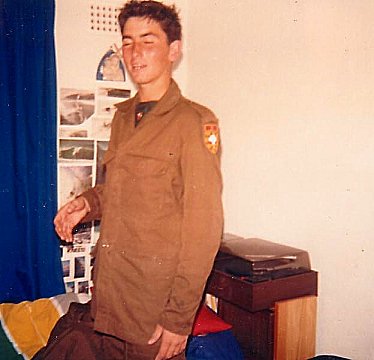
At home on my first pass.
THE OSTRICH
The emblem of 1SAI is the Prince of Wales' feathers. Because of this we had a regimental ostrich, which would walk between the two perimeter fences. This was quite daunting when you were standing guard, as you would only see the ostrich when it was right on top of you. We were told that if the ostrich ran at us (which it did quite often) that we were to hold our rifles above our heads to appear taller than the ostrich. This worked but was still quite scary in the middle of the night to find that you were being "stalked" by a gigantic bird. One morning on parade however we were told some "sad" news. During the night we had had a thunderstorm and the ostrich had taken a direct lightning strike - dead. The RSM ended the sad news with the words "Ons gaan lekker braai vanaand!" (We're going to have a good barbecue tonight!)
SECOND PHASE
When we got back to Bloemfontein it was in the early hours of the morning and we were told that we would have a normal inspection at 7:00am. This brought us back to reality quickly. We were under the impression that we had cleared the biggest hurdle and that things would be easier now that basics was over - how wrong we were. We had to pack our browns away and get back into overalls. We were made to choose if we wanted to do specialised courses - drivers, gunners, mortarists, assault pioneers etc. I did not have a drivers licence yet (I was still a few months shy of my 18th birthday) and I wasn't keen on anything else so I thought "what the hell, I'll stay an infantryman".
All the infantrymen were transferred to different companies for second phase. I was moved to Charlie Company under the leadership of Captain Terblanche. This was a man that was very strict but also very fair. Once when we failed a fitness evaluation he made the whole company go for a run before breakfast every morning --we soon picked up our fitness levels. A few weeks into second phase we were told that we would be going to "De Brug". This was an area of land owned by the army that was miles out of Bloemfontein. We were taken there in SAMILS(1) and when we got there there was a whole camp set up. The days were mainly made up of learning the backbone movement of infantry movements all over the world - fire and movement. This meant that you leapfrogged past your fellow soldiers in jumps of about 10 metres at a time while they covered you with fire. When you got to your position you had to fall flat and commence firing, covering the movements of the people who were now moving past you. I remember one day we were practising this when a guy called "Gyppo" (11) (he got "gyppo-guts" on the first day of basics and the name stuck) could not seem to run in a straight line. This is very dangerous because if people are behind you and are firing past you, you obviously don't want to run into their line of fire. While practising this we never used to (yet) use live ammunition. We would instead shout "tap, tap" or "bang, bang" to simulate the double shot that we had been taught. However Gyppo couldn't run straight, so to teach him how to, Captain Terblanche pulled out his 9mm pistol and told him "I'm going to shoot either side of you, if you don't run straight you WILL get shot". He then proceeded to do just that - standing behind him, he made him run up a hill in bounds and fired a number of shots either side of him. Gyppo never ran skew after that, although he eventually became a store man I think - another one not cut out for the infantry.
While at De Brug we used to catch sight and sound of our future transportation - the Ratel 20 ICV. While we were practising our fire and movement, the drivers were learning off-road vehicle handling and the gunners were practising their drills. I suppose that somewhere else our future section leaders were receiving their training too. Every now and then we would do live fire exercises, which everyone enjoyed except that it had one drawback - cleaning your rifle in extremely dusty conditions - even worse if you had a night fire exercise.
People think of the OFS as hot - well it is, but only from about 11:00am. The nights are absolutely freezing. At night I would sleep in tracksuit bottoms or thermals, vest, t-shirt, jersey, jacket, overalls and aapjas, (12) with socks and boots on while in my sleeping bag - and still get cold!! In the mornings on parade you had to move your hand slightly (without being seen) while holding the barrel of your rifle as it felt as if your skin would stick to the metal of the barrel. Of course after breakfast you never had time to take all of the layers off so that when you started running around you would get boiling hot!
Near the end of second phase we were to have another pass. We were at De Brug, expecting to be taken back to Tempe in SAMILS (1) when they sprang a lovely surprise on us - we were to walk back to base! Nobody was expecting this and it was the hardest route march I have ever done - full kit for about 30 kilometres I suppose. When we made it back into base we were told that we had about 2 hours to get ready if we wanted to go on pass. I don't know what we had done but we had really pissed off the instructors somehow. We worked like crazy, cleaning rifles, ironing browns and polishing boots. When we were called to fall-in we were marched around the parade ground at double time so that our boots became very dusty and dirty. We were then told that we couldn't go on pass looking like that, so we had to go and clean ourselves up again. This happened for about an hour or so. When they eventually decided to let us go it was quite late. At the time the only people that were allowed to leave in the evening were the guys who were being picked up or catching trains (there were no buses laid on this time for some reason). If you were going to hitchhike then you were only allowed to leave in the morning due to the number of SADF troops that had been killed on the roads. Myself and a friend, Andre Kruger came up with a plan. We bought a train ticket to Trompsburg about 150-200km outside Bloemfontein. So we left that night, slept a bit on the train and then got off at Trompsburg at about midnight. We then walked to the main road to Cape Town and started hiking. Well we stood and stood for hours in the freezing cold. We eventually got a lift to Colesburg, where we stood next to the petrol station. AT about 10:00am the next morning an old lady pulled up in a VW Golf and asked us where we were going. We told her Cape Town and after checking our military ID's she opened the doors for us - lovely! The heaters were on, there was classical music playing and Andre went to sleep in the back almost straight away. I joined him soon after and I remember waking up at some point, looking at the speedometer and realising that this gentle old lady was doing about 200kmph! I shut my eyes and went back to sleep. When we got to Beaufort West near lunchtime, this kind lady insisted that she buy us lunch. After eating we set off again and it wasn't long (at that speed) before we reached the outskirts of Cape Town - early evening. She insisted on dropping us both off at our doorsteps - even though they were on the opposite sides of Cape Town. I never asked her name, but I would like to say a big thank you to whoever you were.
The return journey did not go as well. In all it took us about 10-12 lifts to get back to Bloemfontein. For the final part of our journey we were picked up by two black guys in a bakkie (13)- we sat in the back, in the open next to an oily car engine so we couldn't huddle down out of the wind - still a lift is a lift. To make matters worse they dropped us off outside the township in Bloemfontein and we had to walk the rest of the way. I think we eventually got into our bungalows around breakfast time.
Now that our training had finished we went back to our old Companys, platoons and bungalows. Here we were joined by our new drivers, gunners and section leaders. My section was all English with the exception of our gunner - a guy called Van Der Merwe. I suppose after a while he became an honourary Englishman. We all knew each other from basics and got on really well.
One day we were taken to the old school area in Tempe (home of the famous "Tempe Tigers" Girl School). Here we had an afternoon of "Boere Games" - a lighthearted assault course I suppose involving team games etc. One of the obstacles involved jumping up onto the edge of a steeple chase hurdle, running across it and jumping off the end before the next person was allowed to go. I jumped up, lost my balance, fell off and landed on my left elbow. The pain was excruciating! I was told to sit out the next obstacle, which I did, holding my arm still. When it was time to leave I realised that I couldn't move my arm without flashes of pain. I was sent to 3 Military hospital where a very annoyed doctor (it was about 17:30 and time for him to knock off for the evening) agreed to X-ray my arm. He couldn't see anything and came up with the idea of it being dislocated and proceeded to try and put it back! The noise I made must have alerted some of the other doctors because an orthopaedic surgeon was walking past, came in to see what was happening and pointed out a fracture in my elbow. So my arm was put in plaster (but because it was late the doctor did it in a hurry and set it skew - something I still live with today).
RIOT PATROL
Our first operational duty was riot patrol in Venda. This was actually very enjoyable. We were taken up in SAMILS (1) - which took a whole day. When we got to our "base" we found that the whole thing had been set up already - tents, store, kitchen etc. Also for the first time we were given vehicles - Buffels - in which to do our patrols. Life here consisted of waking up, having breakfast, short parade and then going on patrol. Most of the time we would just drive around the villages and occasionally do a road block - we never heard or saw anything untoward. All in all it was a very "rustig" (14) time. My arm was still in plaster so when we first arrived I was put in charge of the store. This was great as I slept in the store tent on my own with lots of space and my choice of mattresses! We had a chef with us who I got to know and he introduced me to the music of the Cure. He was a heavy dope smoker and would sometimes mess up the food a bit - once he put salt in the coffee instead of sugar! After a while though I got bored and asked to be allowed to go on patrol with my mates. We saw some wonderful countryside and gained insight into the local population. I remember one day seeing a group of boys going through their initiation into manhood, covered in white mud, heads shaved and wearing loincloths. I suppose they were heading to (or coming back from) the bush for their circumcisions - a privilege to witness.
LOHATLA
After this was finished and we had returned to Bloemfontein, we made our way to Lohatla - The Army Battle School. Here we would get our final training in Mechanised Infantry drills. We had heard in advance how tough this was going to be as Lohatla is an enormous place in the North West of South Africa and is owned solely by the army. Here we would go out for a week or so at a time and practise fire and movement with the vehicles. This consisted of the Ratels moving forward in a line, stopping, opening fire with the 7.62mm machine gun and 20mm cannon, opening the doors and we would debuss. We would run out, take up our positions and then move forward in leaps and bounds, shadowed by the Ratels. When it was time to enter the Ratel again the driver would sound a horn and we would climb in again. We would practice this for hours on end, sometimes with live firing. Every so often we would do mock night attacks which were quite spectacular as these were often done on a battalion basis.
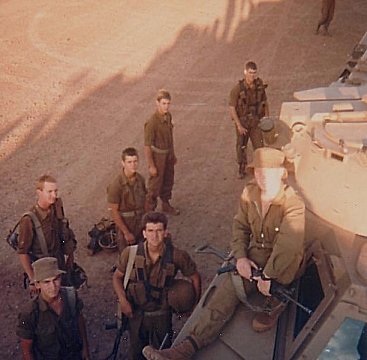
Charlie section. Clockwise from sitting: Dave Hobbs, Andre Kruger, Damian French, Mark Stanley, Mark Van Schalkwyk, Sven Veltman, Wayne Brider.
Every Friday we would head back to the main base to prepare for inspection on Saturday morning. This involved working for literally the whole night. The Ratel had to be washed completely, inside and out, the engine had to be cleaned, filters cleaned etc. This took hours in itself as there were only a few wash bays to be shared amongst the whole company. The 20mm cannon, machine gun and the LMG (15) all had to be cleaned and laid out on a ground sheet as well as our personal weapons. Our section usually split into groups. Some of us would help Dave Hobbs our driver clean the Ratel while others helped Van Der Merwe our gunner and Mark Van Schalkwyk the LMG (15) gunner to clean the weapons. The next morning you had to stand, section by section in front of your vehicle while you were inspected as a team. If the inspection was satisfactory you were given the rest of the weekend off - if not you were given an "oppie". I can't remember what it was - maybe a bad inspection or weak drills in the field, but one day, a Saturday, all our Lieutenants and corporals were given an "oppie" by the RSM.(16) This was a Mech "oppie" meaning that all the punishment consisted of Ratel spare tyres and towbars. We ended up paying for this though as all their anger and frustration was transferred onto us later. We were due to finish our training at Lohatla with a brigade exercise. However I had failed my matric the year before by failing two subjects. I had put in a request to be allowed to re-write History the next year. So once again I was allowed to travel to Bloemfontein and then get a train to Cape Town. The only transport back to Bloemfontein was in the back of one of the SAMILS (1) that regularly went to pick up supplies etc. This was great - I had the whole of the back of the SAMIL (1) to myself and after spending the last few weeks with little sleep I made a bed for myslef and slept most of the way
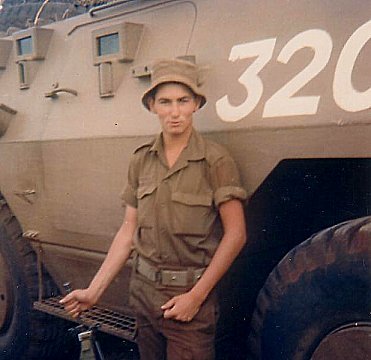
Outside my Ratel - 32 Charlie.
Back in base I showered, handed my rifle into the store, changed into my step-out browns and was taken to the train station. The only time I had been on the train before was when we first "klaared in".(17) This was different - I was the only National Serviceman on the train. People looked and greeted me with respect and I felt a lot of pride in my uniform. After a non-eventful journey I arrived in Cape Town. I wrote the exam at my old school and passed! I was only supposed to be gone for a few days, the plan was to return immediately and join up with my section for the final mock assault. However two days before I was due to leave I received a call from Andre Kruger - he told me we had a ten day pass!! When I asked him why he said "We're going to Angola" I had to call the Castle and confirm that I had received the message. I did this and it was confirmed - we were going operational! After a rather nervy pass we all made our way back to Bloemfontein where we put everything into our trommels (3), along with our civvy kit and put it into the stores. It was now time to say goodbye to our instructors and say hello to our new NCO's and officers. When I went to say goodbye to the corporals I think they knew what was happening in Operation Modular at the time because they looked a bit worried and they said "Be careful, remember what we have taught you" - for the first time they looked at us as equals. We were taken to Waterkloof Airforce Base and by airplane to Rundu. This is where the biggest adventure of my life started.
OPERATION HOOPER
We got off the plane, wide-eyed and excited and almost immediately crossed over the border into Angola, just. We were taken to a large base that had been set up for climatisation and demobilising. For the next few weeks we were briefed on the current situation and what our role would be in the war. Life was still pretty rigid as our new NCO's and officers were trying to make an impression. This soon stopped however - it was VERY hot and I don't think they could be bothered to mess us around. On the first few mornings we were made to go for runs, but this also soon stopped. Most afternoons we were allowed to change into PT clothes and left to our own devices.
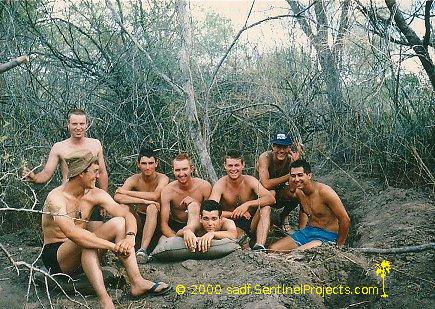
English guys stick together. L-R Basil DaCota, Dave Hobbs, Damian French, Mark Stanley, Simon Inglis (medic), Andy Smythe, Manuel Perreira, Daniel Bottwood (leaning on sandbag).
Every now and then we would see the "Ou manne" (18) coming back from the front. A lot of them looked quite haggard - not only because of the long hair, beards and dirt but because you could tell that they had been through one hell of an experience. They told us stories of what to expect - at first I thought they were laying it on a bit thick but later realised that they were being truthful. We also saw, for the first time, the legendary camouflaged Ratels of 32BN. A few days before moving out of the base Andre Mory received news that his transfer to the Castle had come through. He was very happy to be leaving and that night we all got very drunk.
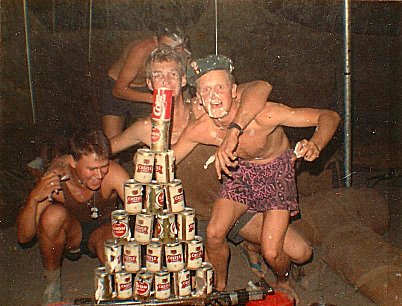
Andre Mory's (surf shorts and beret) last night in Rundu.
Eventually we were told that we would be moving up to Mavinga, a UNITA stronghold to undergo final training before moving to the front. That night we were taken back to the airport, boarded planes and set off. When we arrived at Mavinga things looked very different, we were now in thick bush and it was very humid. That night we were told to bed down in a shona.(19) We set up our bivvys and went to sleep. The next morning we were taken to our respective vehicles that were parked in a large laager. However when my section, 12C got to the spot where our Ratel should have been there was a Buffel in its place! What had happened was that during Modular our Ratel had been destroyed. Apparently the fire was so bad that the shells from the machine gun and cannon had melted onto the floor. So we were given a Buffel while a replacement Ratel was sent for from South Africa. Our time at Mavinga was spent going out most days and practising our drills, but this time we were working very closely with the Olifant tanks from the School of Armour. We also practised doing fire and movement with UNITA.
We would go driving in our Buffel, which wasn't the easiest as the Buffel couldn't go where the Ratels could. We had to go around bushes or small trees while the Ratels just went over them. Also it took longer to de-bus from the Buffel than it did from the Ratel. Every now and then when we weren't practising, Dave Hobbs and I would act as chauffeurs to Captain Walther a high ranking UNITA officer.
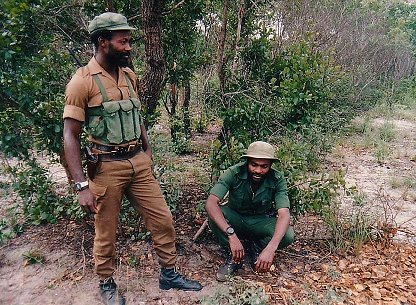
Captain Walther and guard.
We would pick him up from HQ (where I suppose he was being briefed by the SADF officers) and take him to various UNITA villages and bases. He would often be accompanied by one or two guards and when Captain Walther went inside somewhere the guards would remain with us on the Buffel. We would talk in haltering Portuguese that we had picked up (I knew rudimentary Italian) and hand signals. I remember showing them a magazine from South Africa and they were amazed by the cars and pictures of the beaches and sea!
FOOD
Our only rations in Angola were ratpacks. We were used to these from Lohatla but here they quickly became monotonous. A standard ratpack consisted of fuel tablets for heating water, matches, 2 sachets of white coffee, 2 sachets of white tea, sugar, a sachet of "Pronutro" porridge, 2 sachets powdered cooldrink, small tin of meat (corned beef, chilli con carne, a strange pickled or curried fish and a kind of beef stew), one small tin of vegetables (peas or mixed vegetables), 2 small chocolate substitute bars, one roll of glucose "Super-C" sweets, 2 small tubes of softish cheese, a packet of "dog biscuits" and some polythene bags. For me, my breakfast usually consisted of coffee and cheese on biscuits. Later in the morning (10'ish) I would have my porridge (which was made by pouring the powder into one of the polythene bags adding sugar, tying it closed and then shaking it together. The mixture would then be drunk directly out of the bag). Later in the day I would have my tin - normally cold. For "snacks" during the day I would eat my sweets and chocolate. At night I would have my other tin (heated), another coffee and some more biscuits. For this reason I came home weighing 52 kg.
Every now and then (but very rarely) we would get "wet" rations. This usually consisted of bread, tins of additional meat and tins of condensed milk. Condense milk was a hugely sought after commodity. We used it to sweeten coffee but mostly we just drank it straight out of the tin. As you can see a large part of the rat pack consisted of high energy food and the condensed milk was an energy top-up. I don't know how we would have survived without our "sugar" fix.
DIARRHOEA AND SICKNESS
Due to the poor diet and also because of poor hygiene (there were NO showers and not enough water to wash with) almost everyone developed diarrhoea. This had some amusing if disgusting consequences. I remember Mike Smith from Durban, a very tall driver from Durban who had a really bad dose. One morning he woke up to find that he had crapped in his sleeping bag in the night. Our section leader Andy Smythe also went through a bad spell and I can recall coming back from an afternoon of practising manouveres, in our Buffel and shouting at Dave the driver to avoid the bumps and dips in the road. He felt that every time we hit a bump he would shit himself! But undoubtably the funniest occasion for me involved Mark Stanley. We were practising a live fire exercise just north of Mavinga. I was rifleman 1 and Mark was rifleman 2 so were always next to each other. Mark had been having a bad case of the runs. So were running through the bush in leaps and bounds, firing away when all of a sudden Mark stops, pulls down his trousers and ejects a stream of water. It was like someone had turned on a hose inside him. This jet of "water" (because that's all it really was) was hitting a tree about 12 feet away. When I looked at Mark he just had this enormous grin on his face and I laughed so much that I dropped my rifle. I was in such a state that I picked it up by the barrel, forgetting that I had been firing with it for a while and that it was boiling hot and ended up with a nice blister on my palm of my hand.
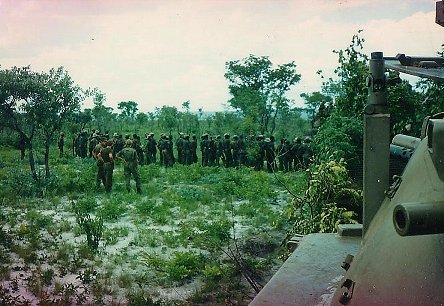
UNITA debriefing.
It was around this time that some of the guys first started feeling sick. Malaria and Hepatitis was to claim a few lives and a lot more evacuations later.
Soon, mid December, we were told that we would be moving out of Mavinga and up to the frontline. Because we couldn't take our Buffel with us our section was split up. We all had to find another section to ride with. I chose a section from another platoon that was half English and was led by a section leader called Paolo. I took the anti-aircraft gunners place at the rear and eventually we moved out.
On Christmas Eve we came to the Lomba river, scene of fierce fighting in Operation Modular before us. The signs of this were clear - burnt out tanks and vehicles. The going here was incredibly tough as most of the vehicles were getting bogged down in the marshy soil so that it took hours to move a few hundred metres. I was standing behind our Ratel, with the rest of my adoptive section in the middle of the night, looking at my watch and saying "Happy Christmas everyone" Happy Christmas indeed! The following day, Christmas day, we were allowed to rest but apart from that nothing special happened.
FIRST DANGER
Shortly after Christmas I began to feel ill. I would sleep all day in a fever, eat very little and drank just enough to keep going - if I drank too much it all came back up again. I would spend whole days just lying in front of the Ratel, using it for shade, shivering. On New Years day 1988 we had our first action. In the night we moved up to the high ground that overlooked the 21st Brigade of FAPLA.(20) From here we started shelling their positions mainly with mortars and the big G5's.(21) We were allowed to stand up in the Ratels with the hatches open and listen to and watch the spectacle. However soon mortars started coming back over our heads. I remember thinking for the first time that we were at war properly - someone was trying to kill us!! We eventually left our positions and moved to form a new laager for the next day or two. The next day, January 2nd is one that lives in my mind forever.
Ever since we had left Mavinga we had received several "Victor Victor" calls. This stood for "Vyandlike Vliegtuig" (enemy aircraft). At this call over the radio everyone would pull off the path and into the bushes where we would quickly camouflage them with branches. We heard several MIG's and sometimes we would spot them at high altitude, but they wouldn't see us. We became very brave, not staying in our Ratels while in danger, as they had never come very close. This was to change after January 2nd. I was by now severely ill, so when we returned from our bombardment of the previous night I was too sick to dig a proper foxhole. It was standard practise that wherever you stopped and made a laager that everyone would dig a fox-hole - a hole about 4-6ft deep to jump into should we come under fire, from land or air. I was too ill to dig one the previous night so the next morning at about 10am I started to dig. However I was so weak that I only managed a hole about 1ft cubed. We had heard planes circling us for a while - they obviously knew we were in the area from the night before. We could hear them at high altitude and I was listening to one high up while sitting next to my meagre hole. He was circling but the next moment the sound stopped altogether. Dead silence and then came the scariest sound I have ever heard - he had turned into a dive and was coming to bomb us! The engine screamed and the noise seemed to fill the whole sky as he came swooping down, dropped a 250-pound bomb and levelled off at tree height. The next thing I knew I was in my little hole, staaldak (4) on, curled up in the foetal position looking upwards. The sight that greeted me is one that I will never forget. As I looked up the plane was flying directly over our positions. It was so close that I could see the communist red star on the wing. Then it pulled up and was gone. The sound of the explosion was increased by hundreds of fist-sized bits of shrapnel flying through the bushes, hitting trees - one went right through a water bunker. Afterwards we walked around and picked up bits of the shrapnel which were still hot. I couldn't believe it - no one was hurt! It was a speculative attack by the pilot, as I don't think he knew where we actually were, more luck really.
NEW RATEL
It was a short time after this, a few days later that word came around that I could return to my section as our new Ratel had arrived. I was glad about this, as although the guys I had been staying with were great friends it was fantastic to get back to my "family". For a long time in Mavinga we had been the butt of many jokes about our Buffel but now it was our turn to laugh. All of the Ratels that were in use had been through a lot and were quite battered. Ours was brand new - everything worked!! The main example was with the weaponry. In almost all of the other Ratels the solenoids for the cannon and machine gun did not work. The gunner's section in the turret is quite cramped. There are two levers one for elevation and one for turning the turret. On these levers are the triggers - one for the 20mm cannon and the other for the 7.62mm machine gun. If the solenoids work correctly these are fired electronically however if they don't work you have to fire them manually which can be quite hard work as the 20mm cannon has to be struck with the palm of your hand. This can be quite tiring and painful after a while. So Van der Merwe our gunner was ecstatic when he tested the solenoids and found them to be perfect.
We moved from laager to laager, sometime staying for a day or two, sometimes for a week or so. When we found out that we were to stay in one place for a reasonable time we would set up our "home" around the vehicle. Often 2 or 3 men would share a foxhole and share the job of digging it. If this were the case we would dig a very large hole, cut logs and lay them on top, cover it with sand and leave a small entry hole. We became quite good at building more sophisticated variations of these.
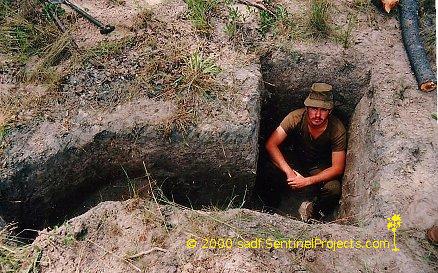
Dogleg foxhole awaiting roof.
FLIES
One thing that bugged everyone was the flies, you couldn't escape them. They lay on you in the hundreds. One day we photographed about 150 flies on Mike Smith's back. They were in your food, at the side of your mouth and trying to drink from your eyes. If you had an open sore then they sat on that. I had scratched my elbow during the MIG incident and now it was infected. This happened to everyone - if you scratched yourself on something it was guaranteed to fester. To relieve boredom I would sit with my thumb and forefinger on either side of this wound and gently pick flies off. We became quite sadistic with these poor flies - pulling their wings off to make them "walks". Daniel Bottwood and I also discovered that you could take a small feather and using the sharp end shove it up the fly's arse and then let it go. The poor fly would then fly off with the feather still attached - hours of amusement!! We thought that there were loads of flies because of the rubbish dumps and toilet holes that we made and at first we thought that once we moved laager the problem would stop for a while. However we soon began to joke that the flies had "recces" because as soon as we arrived at a new spot the flies would be waiting for us!!
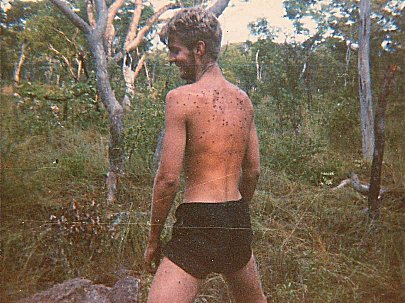
Mike Smith covered in flies.
DUNG BEETLES
Another bit of local wildlife that was more amusing than annoying were the dung beetles. These were obviously attracted by our toilet holes. I know it sounds disgusting but sometimes I would sit for ages watching them go through their ritual of preparing the "dung". The toilet holes were fairly basic - about 4ft deep, which you squatted over. Sometimes a smooth branch from a tree was used for a seat (one that had a good fork in it). You could hear the dung beetles coming from far away. Their buzzing would gradually get louder until you finally spotted them, like miniature helicopters, homing in on you. When they were close to or above the hole they would simply close their wings, drop and begin work immediately. Obviously not everyone found them so amusing. One guy from another company lost it totally and emptied a full magazine on automatic fire into the toilet hole, shouting about "the fucking dung beetles!". He was sent home.
RADIO CHARLIE
Music was our only connection with home. Some of the guys had walkmans but batteries were always in short supply. To combat this crisis we came up with an idea. It originated, I think, with Andy Smythe who was a DJ in civvy life. There is an intercom system in the Ratel so that the section leader can talk to the troops inside. So one day he put the microphone next to the walkman earpiece and played us some music through the intercom. The plan developed - we asked around for spare batteries and hooked up the walkman to the radio. We then let a few of the other sections know a spare channel on the radio and "broadcast" music in the evenings. Word soon got around that "Radio Charlie" was in operation and I think that before we were told to shut it down we had quite an audience. I seem to remember a lot of "The Cure" being played, which is probably why we were shut down.
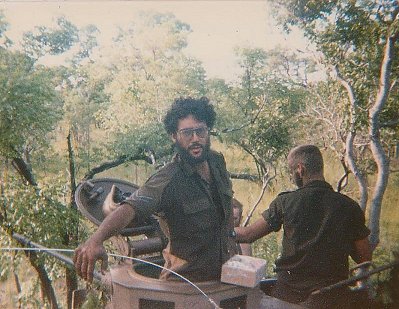
Corporal Andy Smythe - Radio Charlie DJ.
21ST BRIGADE - 13th JANUARY 1988
Soon we received word that our first proper contact was to occur. Our objective was to remove the 21st FAPLA (20) Brigade from their positions. On the day of the battle we lined up in our positions at about 5:00am. We waited for the SAAF to bomb the positions with Buccaneers and Mirages. Soon after this the artillery opened with the G5's (21) followed by a battery of MRL's (22). Soon we were given the order to move forward - our first contact! From my position as rifleman number 1 I was facing backwards although I had the advantage of looking through the drivers window. This was an almost textbook battle - at the end of it the whole Battalion hadn't lost a single man! The going was extremely slow as once day broke we were hampered by "VV" calls as the sky had cleared and the MIG's could fly from Menongue. I think we eventually hit contact at about 14:00pm. The sight that greeted us was one out of a Vietnam film. Everything I had seen in the movies was the same - the terrain as well as the chaos. Pretty soon we came upon the enemy positions - lots of trenches and bunkers with T34 tanks dug in. We had learned to do bunker and trench clearing drills but here we saw an easier way of doing it - simply drive an Olifant tank up to the bunker, position the 105mm barrel inside and let of a HE round - no more bunker! Van der Merwe was having a great time, shooting away at targets and anything that moved. The noise inside the Ratel was incredible. The smell of cordite filled the inside. It was incredibly hot inside as we had all the hatches closed and fear and excitement was leaving us all drenched in sweat. I looked over at Mark and he was grinning, shouting to Van der Merwe "soek, soek, soek" (seek, seek, seek) The Ratels had a much quicker turning turret than the Olifants so they would watch where the 20mm cannons were firing and then hit the same target.
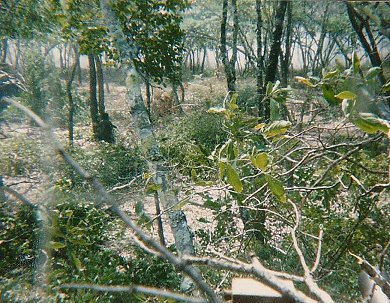
First contact as seen out of a Ratel window.
The battle went on into the night. Now it became quite hard to see where the tank traps, trenches and bunkers were. We were moving forward when all of a sudden the Ratel tilted. Dave put it into reverse and went straight back into a bunker, the back wheels stuck. We got out in the middle of the battle to try and push it out. Reversing into the bunker probably saved our lives though as just as we went back and RPG7 flew past us and hit an Olifant on the tracks next to us. The sight, smell and noise (there was a ZSU23mm close by somewhere) of the battle will stay with me forever. Soon Dave managed to get the Ratel out and we dived back in to continue.
Eventually we were given the order to withdraw to a hide for the night. We had completely routed the 21st Brigade whilst receiving no serious injuries or losses. When we got back to the laager for the night we were all completely shattered, we had been up for about 24 hours and Dave in particular just fell straight asleep. Some of us made some food, drank water (we were all dehydrated from sitting inside the Ratel, hatches closed all day) and talked about the battle. The next morning we formed up again and moved through the battleground yet again - this time checking for stragglers, counting the dead and removing captured vehicles and weapons. Every now and then we would hear a quick skirmish in the bushes but it was quickly dealt with.
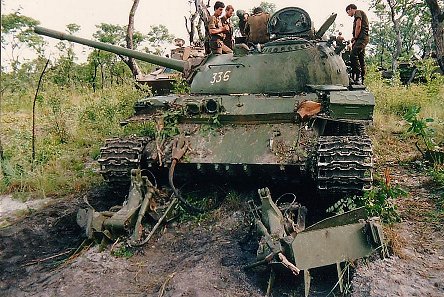
Russian T34 tank.
It was here that something happened to me that I found deeply disturbing for many years afterwards. Riding around I found myself laughing at the sight of the dismembered bodies. Instead of feeling shame or revulsion, I laughed. I realise that it was my minds way of dealing with the situation but for years afterwards I felt a great shame that I had been so disrespectful to the dead, many of who looked younger than me!
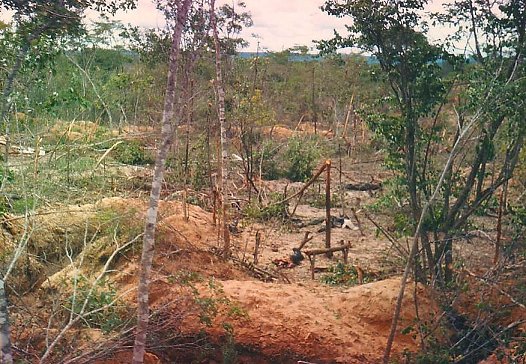
Trenches and bunkers of the 21st Brigade.

Bunkers of the 21st Brigade, the morning after.
We were told before the battle that many of the FAPLA (20) soldiers were demoralised as they had no food and how lucky we were to have rat packs etc. However, lying on the tops of bunkers and trenches we found red-cross food parcels with Scandinavian fish, Brazilian biscuits and coffee and various other items.
We were briefed a day later, on a brigade scale, to be told how well the battle had gone. We were shown a piece of a MIG wing that UNITA had shot down with a Stinger SAM missile. We were very confident and felt like no-one could beat us, feelings we would later regret. Although I said that there were no casualties there was an accident that was related to the battle. Some of the guys took "souvenirs" from the battleground and someone took an AK47. He was sitting in the Ratel doorway cleaning it when he pulled the trigger and shot one of his friends through the head, dead.
59th BRIGADE - 14th FEBRUARY 1988
Our second battle was against the 59th Brigade. After a few cancellations due to unfavourable weather the date was set for Valentines Day - 14th February. The pattern was the same - in the early hours of the morning the artillery began shelling the enemy positions with G5's (21) and MRL's (22). At dawn we were greeted by Mirages and Buccaneers sweeping low over our positions on their way to drop their bombs. A few minutes later they returned and we were given the signal to start up and move out. Things started to go wrong almost straight away. We encountered mortars and small arms fire almost immediately. The UNITA troops rode on the back of the tanks and Ratels and I watched through the window as a shell would explode, a UNITA soldier would fall off dead, his nearest comrade would jump down, dig a shallow grave, grab the fallen man's rifle, ammunition and anything else of value, cover him up and jump back on the tank and continue. It was a way of life (or death) for them. The bush was very thick around the 59th Brigade positions and we found ourselves lost on a few occasions. It took us ages to hit full contact and this only happened in the afternoon. Due to the thick bush we were infiltrated by a number of mobile T34 and T54 tanks - most manned by Cuban commanders. On one occasion my old Captain from second phase (promoted to Major) Terblanche spotted a T34 stalking a Ratel through the bush. It was the favoured method to shoot a round into the ground and "bounce" the explosion into the diff of the Ratel or tank. This way the vehicle was disabled and they could take a better shot at finishing off the stranded vehicle. Major Terblanche spotted that this was about to happen. His Ratel had no weapon being a Command vehicle, so he climbed out and was going to throw a hand grenade into the hatch. However there was a lot of small arms fire that prevented him from getting close so instead he knelt down and shot the Cuban commander through the head with his R5. I always knew he was a lunatic.
In the early evening we received the warning that we had all been dreading - to put on our gas masks. We all looked nervously at each other but wasted no time in putting them on. We had all been issued with an anti nerve gas injection in case of an attack. Luckily we didn't have to use it. It turned out that the commanders had spotted a suspicious looking white cloud heading our way but this turned out to be white phosphorous.
We were receiving reports of more tanks that were being sent up from Tumpo to look for us. We were now off the battlefield and in thick bush. Ahead of us was an Olifant with UNITA soldiers riding on top. The next moment there was a huge bang and the tank came out backwards towards us. It had been hit by a FAPLA (20) tank. The crew and UNITA soldiers were all running towards us and Andy told Dave to go and pick them up. Dave drove straight ahead with the doors open. Everyone dived inside - gunner, driver and about 5 UNITA soldiers. They were all pretty shaken up and then the gunner and driver started shouting "Where's the lieutenant?, Where's the lieutenant?" We drove forward again towards the tank and then saw him - he was staggering around holding his face. Mark and I jumped out and helped him inside. We opened up a medical kit and tried to treat his wounds the best we could - his eye was almost gone. We laid him down on the floor with his head in my lap, me holding a bomb bandage over his eye to try and stop the bleeding. We radioed that we had a casualty and made our way back towards the medical position where we dropped everyone off. On the way we gave everyone water and cigarettes (I think even the non-smokers had a few!). Apparently what happened was that they were hit, everyone bailed out except for the lieutenant who tried to put a fire out with an extinguisher. A shell then exploded in the barrel from the heat, injuring him. He did indeed lose his eye.
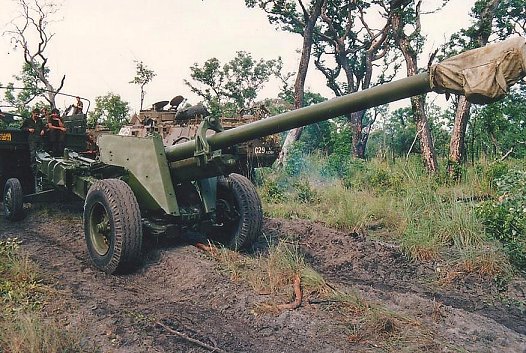
Russian D30 artillery cannon.

GAZ truck used to tow D30 cannon.
Eventually we were given the order to withdraw back to a laager to rest and replenish. We were all shattered after a long fight and also emotionally drained due to everything that had gone on that day. It seemed to me that things started going downhill after this. The next day we were driving back to the battlefield when we passed the Ratel that had been shot out, killing 4 men. As we passed we could see 4 perfect 23mm holes on the one side and a massive hole on the opposite side. Standing outside the Ratel was the Corporal of the section and he was completely devastated, crying his eyes out. I had been in this section during second phase and knew all the guys that were killed. This affected me quite badly too.
We started getting more "Victor Victor" calls now and the MIGS and SU22's started flying nighttime missions looking for us. One night they dropped 4 or 5 huge illumination rounds that burnt for about 15 minutes. We were told not to light fires - all cooking had to be done before sunset and cigarettes were to be smoked undercover so as not to show the coal. These aircraft attacks (mostly speculative) and flights were starting to affect me. I would imagine hearing planes. Daniel Bottwood had the same thing. Sometimes we would hear imaginary planes at the same time!
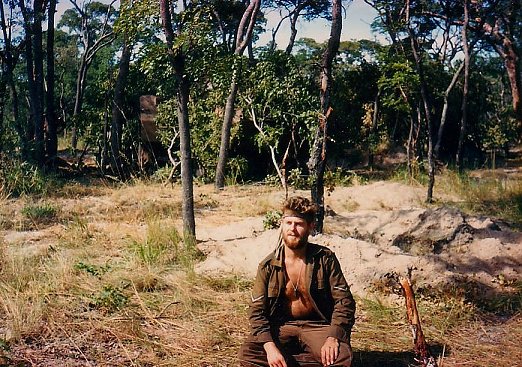
Medic Simon Inglis in front of foxhole and well camouflaged Ratel.
We would not take the "Victor Victor" calls lightly any more and would dive for cover when the warning came. One day a water bunker came around and we were told that if we wanted we could have a "shower". This only happened twice I think. Basically you stripped naked and the guys on top of the bunker would hose you off, you would have a quick wash and then they would hose you off again. The only other times we had a decent wash was when it rained - all over, men would be running around naked with soap, washing furiously. One day Daniel and I had just finished washing and we were walking back to our Ratels when we heard a plane, low and fast, approaching. Within a second it was on us and we through ourselves into the nearest hole we could find - the rubbish hole, filled with empty cans and wrapping from ratpacks. We were wondering why we didn't get a warning when the plane did a barrel roll above us - they were Impalas!
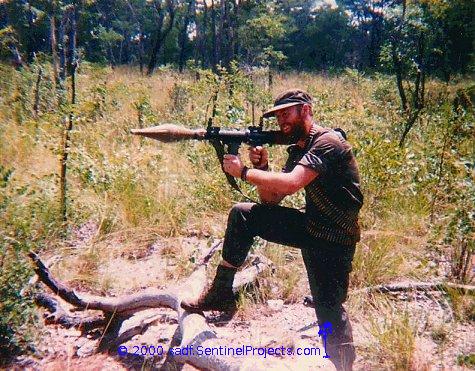
Dave Hobbs in full FAPLA camouflage uniform with RPG7.
A few weeks after the last battle we found out that our company would not be taking part in the next battle. 4SAI had been the main attack force in the previous two battles with 61 Mech as the flank attack. This time they were to be the main force with the tankers. This was known as "The Tumpo Battle" - mainly because it was known that FAPLA (20) had a large concentration of tanks in that area. Our platoon was to provide Anti Aircraft cover on the high ground overlooking the battlefield as well as a clear view (through binoculars) of Cuito Carnevale.
We made our way to our positions in the night and the next morning after digging in we went up to the look out position. In front of us was a huge valley with Cuito Carnevale in the distance. On the high ground with us were the Cactus missiles. When the battle began they tried to attract MIG's away from the attack force. They did this by cutting logs to look like artillery barrels and then placed smoke grenades next to them. When there were planes in the area they would set these grenades off to make it appear as if the "cannons" were firing. When the planes came in to attack the targets the Anti Aircraft batteries would try and engage them. On one occasion a MIG flew right passed our position and one of the Cactus' fired at it. Unfortunately it missed but the system turned so fast that the operator was still standing behind it when it fired, burning him in the blast. The observers lent us binoculars and you could see the G5 (21) shells striking the main tower in Cuito Carnevale. Also in our area were the signallers and interpreters who were monitoring the enemy radio communications. We stood with them outside their Ratel (which was full of high tech radio equipment) and listened to the commentary of the MIG pilots and soldiers on the ground.
As it turned out this was to be the sticking point of the whole war. The route to Cuito Carnevale (which was our objective) was very heavily mined and the tanks could not get through. Quite a few lost tracks and were stranded in the middle of the minefield and were strafed by MIG's and artillery.
WITHDRAWAL
Soon we were told that we would be withdrawing and that Citizen Force troops would be taking over for Operation Packer. We were very relieved as a lot of us (myself included) were starting to show signs of strain. I could not sleep at night for fear of aircraft attack. We started making our way south but one incident was to still occur. We were in a laager and had UNITA guys living alongside us. Sometimes they would ask us for water and we would fill their bottles from the Ratel tanks. This day a guy in UNITA uniform came up to our section and asked for water. We checked our tanks but they were almost empty so we told him to look somewhere else. He went off to the next few Ratels and tanks and the next minute we heard an explosion. What happened was that he was not a UNITA soldier but a FAPLA (20) soldier dressed in UNITA greens and the water bottle was booby-trapped. When the soldier filled it up for him the bottle exploded, killing him. This gave us further cause for concern and from then on we trusted nobody.
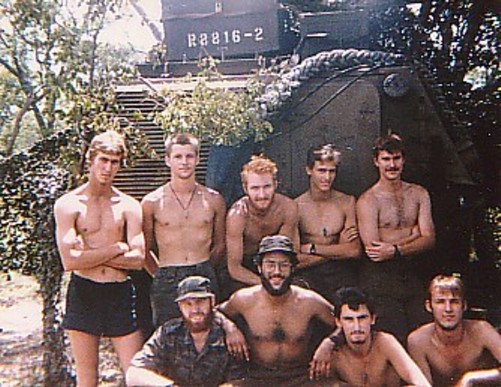
Charlie Section just before withdrawing.
Back row L-R: H Van der Merwe, Mark van Schalkwyk, Mark Stanley, Sven Veltman, Wayne Brider.
Front row L-R: Dave Hobbs, Andy Smythe, Damian French, Greg Spence.
When we were a few days from Rundu we were told to stop and de-arm our vehicles and ourselves. We had to dig massive holes and bury all the ammunition - R4, 20mm, 7.62mm rounds, grenades, everything! Once this was done we drove into the de-mob area that we had first arrived at all those months ago, barrels elevated in fine style. Waiting for us were proper showers - with hot water! It was bliss. We were issued with new browns and all our old clothes were taken away and burnt - they were black with grime. Afterwards we were fed, proper food and allowed to buy beers, which we did in large quantities. I remember that they had some kind of concert with singers from South Africa but I think most of the guys were too drunk to notice.
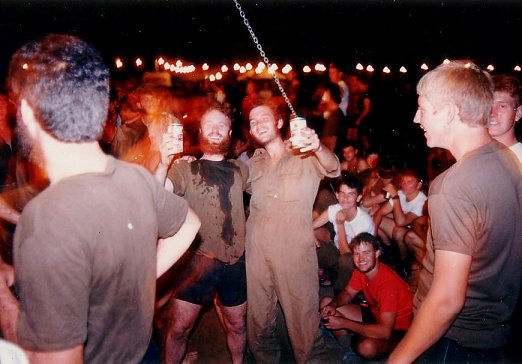
Dave Hobbs and Daniel Bottwood enjoying the party in Rundu.
We were also given some "lovely" t-shirts to remember the happy occasion by. These were white with the following written in the colours of the old South African flag, Orange, White and Blue. They said: "HOOPER (in orange) EK WAS DAAR (I was there (in white)) I DID MY BIT! (In blue). The following day we were taken to see the psychiatrist. This was done section by section and was a bit of a farce. He asked us how we were all coping and we said "fine" and that was that. I think that if he had seen us individually he would have got some different answers but nobody wants to say that they aren't coping in front of their buddies. A day later we were inspected by the RSM.(16) Those who had decent beards were allowed to keep them for the time that we were going to be on leave, others had to shave. I had already shaved into a goatee and was told to remove it. Then we were put on a plane and flown to Bloemfontein. When we arrived we heard that the new intake had been warned to stay away from the "ou manne".(18) Also the guys in charge of the canteen had been told to let us buy as much alcohol as we wanted as opposed to the "2 cans a day" rule. You could see the look of fear on the faces of the "roowe" (23) when these bearded, long haired, wide eyed drunkards were walking around "their" base! We were only there a day or two, just long enough for us to hand in our kit and collect our personal belongings. After leave, which was 3 to 4 weeks I think, we were to go to our new units. We would be going to 4SAI, Middleburg.
That leave was very strange as I was very happy to see my friends and family but at the same time I longed to get back to my section and friends. People said I looked strange, like my mind was somewhere else and I would find myself sitting in a pub staring off into space - the classic 1000 yard stare. I would cringe at the sound of commercial airplanes and the slightest noise made me jump. At least this was a mild case of PTSD. (24) We heard after pass that a guy who had handled the whole time very calmly and showed no signs of distress, had repeatedly stabbed a female cashier in his local building society to death while on pass.
4SAI MIDDLEBURG
After coming back from our pass we were taken to Middleburg, Transvaal and to our new base. 4SAI is much smaller than 1SAI so this was quite nice for us. We were also issued with new beret badges and flashes etc. We soon settled into our new home, standing guard and training etc. Life here was quite peaceful.
KRUGER PARK
A short while after moving to Middleburg we were awaken one night and told to pack for an operation. We were very reluctant as we thought we would be going back to Angola. However we soon found out that we were going to be sent to the Kruger Park's northern border to patrol the fence for terrorists coming over the border. We drove up in SAMILS (1) and were taken to our "camp site". Basically it was an area in the bush that had been cleared. After a day we were sent out on patrol - back on ratpacks! These were foot patrols but we soon realised that there was no threat and we could do as we pleased. I think that our experience in Angola had made us feel "untouchable" so most of us put our rifles over our backs or even folded them and put them in our backpacks. We would follow the river for an hour or so and then suntan for the rest of the day. In the evening our guide (from the Park Services) would lead us onto high ground to sleep. They refused to sleep near the river because of the threat of hippopotamus'. We were also told to sleep with our heads in thorn bushes, as there were hyenas in the area - rather lose your feet than your head! After a few days we would go back to our "camp" and have a massive braai and loads of beers, sitting around the fire with the Sergeant Major and the Officers - it really felt as if we were accepted, now that we had seen action. Looking back I think that it was an excuse to send us there --just to give us an easy holiday for a while to recover from Angola.
BORDER
We hadn't been back in Middleburg long when we were told that we would be going to the border to finish our two years service. We were flown up to Grootfontein and then transferred to our Ratels. The drive up to the border took ages, as we kept on having to stop to allow the convoy to catch up. We all slept (except for the poor drivers and section leaders). Around midnight we arrived and were told to dig in next to the Ratels. In the dark I could make out that we were in a kind of laager formation. The next morning we awoke to find that we were parked outside our new base - Etali. The base was square with the entrance from the main tarred road that ran up to the border and cut-line. It was made with a raised wall outside of which was another smaller wall, which we were parked on. We dug the front end of the Ratel in and then shallow "graves" which we slept in so that the whole base was surrounded by troops and Ratels all pointing outwards. In the middle of the base were the mortarists and in one corner an "aapkas" (25) next to the HQ. Also next to the HQ was the canteen and mess. Along one side were a few toilet and shower blocks and a parade ground. In front of the Ratels were two fences about 50m apart with an anti-personnel minefield in between. Every now and then in the night you would hear a mine go off, jump awake only to find that a poor goat or dog had gotten through the fence and detonated a mine.
During the day we would go out on patrol or stay in the base and relax. Relaxing meant playing volleyball, sitting around reading, washing clothes or gambling. Riding patrols was very boring. A platoon at a time would drive a pre-set route looking for any signs of trouble. I think we only acted on intelligence received a few times - searching houses, doing roadblocks etc. Otherwise we would drive for a few hours - most of us sleeping inside - find a large tree, park underneath it and play cards. Mike Smith ran quite an organised Blackjack table. Time was also passed by carving Makalani nuts, or vegetable ivory, as it is known. The amount of surgical scalpel blades that went missing from the medic's packs must have raised a few eyebrows!
One night the water tower on the cut line was revved (26) by SWAPO (27) and a platoon went out to investigate and engage. Our platoon was to stay in base on full alert in case of further attack. We were all very nervous as we could see the explosions and tracers in the sky. Fortunately we weren't attacked and heard all about the incident the following morning. Some SWAPO (27) terrorists had been captured and had been brought back to camp for interrogation. It was our platoons job to guard the prisoners and Mark and I had a night shift. I actually felt a bit sorry for the prisoner as you could see that he was absolutely petrified. He asked for a cigarette and Mark gave him one.
Another night we laid an ambush after some telegraph poles were blown up. We waited all night but nothing happened. That was what it was like all the time. One day after doing a roadblock we pulled off the tarred road and onto a gravel road. I was talking to Dave the driver and looking out of the driver's window when all of a sudden there was a huge explosion in front of us. 12B in front of us had hit an anti-tank mine. I saw someone flying through the air - it was Kevin Miles who had been sitting on the spare wheel on top of the engine compartment. He broke his shoulder, everyone else had cuts and bruises but Mike Smith had cut his head on the driver's hatch. He was bleeding quite badly above the eye and one of the Ratels was ordered to take him to the medics in Ondangwa. We searched the immediate area but found no other mines. A van drove by just after the explosion and a few of the guys stopped and interrogated the occupants about the mine, some quite physically. We then waited for a "Withings" (28) to come and tow the Ratle away.
Because we were living on ratpacks again while on patrol we would supplement our diet by stopping at the local "cuca" (29) shops to buy bread, chips and "Muhango", the local beer which tastes like battery fluid. One day however we decided to go for something a bit more fresh. We approached a kraal and offered to buy a chicken. An old lady set a price of 5 Rand, heavily overpriced, but we were hungry so we paid up. However she would not catch it and just pointed one out to us and then watched our amateurish attempts to catch it. Kevin Miles caught it and offered to kill it - he said he had done it before. I doubt it as it took him quite a while and a struggle to wring the poor bird's neck. The result was that it was so tough when we cooked it that we could hardly eat it, but we did anyway.
Soon our time was up and we spent the last few weeks at Ondangwa, living outside the base in tents. The only time we went inside the base was to shower or use the ablution blocks. We just hung around and counted the days. Eventually the day came when we boarded planes and flew back to Pretoria. From there it was just a few days before we had our final parade and were told which Citizen Force units we would be serving with. I was posted to the Cape Town Highlanders (CTH). Soon we had said our goodbyes, boarded buses, cars, trains and planes and left forever. An important chapter in my life was over.
CAPE TOWN HIGHLANDERS
Almost a year after klaaring out (30) I received my first camp call up. I had been called to the CTH headquarters in Newlands, along with all the "new" men, a few months before to meet the Commanding Officer and officers. We were issued with our new caps and cap badges and told about the history of the regiment. However that didn't count and now I had my first real "camp" call up
I was told that I had been selected to be a 20mm gunner and was to go to Lohatla early for training. Instead of a 28-day camp call up, myself (and others on the course) would do a 35-day call up. We went to Wingfield and caught the train to De Brug and from there went by truck to Lohatla. This time in Lohatla it was different - here we were all equal, "ou manne" (18) and not "roowe" (23). The NCOs didn't give us a hard time, as they knew many of the older guys from previous camps. No one shouted or chased us. Everyone respected everyone else. Because everything was still fresh in my mind I picked up the gunnery course very quickly and actually quite enjoyed it. Some of the other guys had never been in a Ratel before, coming from Motorised units. The camp passed without incident and soon we were pulling into Cape Town train station and were greeted by a lone piper playing us home.
One year later I was called up to Lohatla again, however this time as a rifleman. Being a year older and not so keen this time I decided to see if I could have and easier time. I pulled out my G3K2 classification and said I couldn't carry a rifle. They asked me if I would be interested in being the Officers Barman for the camp and I jumped at the chance. One month sun tanning during the day and selling alcohol at night - lovely!
The following year I left South Africa to begin a new life in the United Kingdom.
GLOSSARY
1. SAMIL - Large Bedford type truck used for carrying supplies and troops.
2. G5K5 - medical classification that meant you were not fit, physically or mentally to continue training.
3. Trommel - Large steel trunk used to store kit.
4. Staaldak - literally "Steel Roof" - name given to kevlar helmet.
5. Varkpan - literally "Pig pan" - metal plate with 4 or 5 compartments to eat off.
6. Pikstel - kit consisting of knife, fork and spoon.
7. Pap - Afrikaans for porridge
8. Jaag - Afrikaans, To chase
9. Houding - Afrikaans, Attitude
10. Balkie - Afrikaans, badge
11. Gyppo guts - diarrhoea
12. Aapjas - Afrikaans, literally monkey coat. Thick coat with fur lining.
13. Bakkie - pick-up truck
14. Rustig - Afrikaans, restful
15. LMG - 7.62mm Light Machine Gun
16. RSM - Regimental Sargeant Major
17. Klaared in - Afrikaans, joined up
18. Ou manne - Afrikaans, literally "Old men"
19. Shona - flat, open area
20. FAPLA - communist run army of Angola
21. G5 - 155mm artillery cannon
22. MRL - Multiple Rocket Launcher
23. Roowe - Afrikaans, new, young troops.
24. PTSD - Post Traumatic Stress Disorder
25. Aapkas - Afrikaans, literally monkey cage, a tall structure with a cage on top used as a lookout.
26. Revved - to be attacked
27. SWAPO - South West African Peoples Organisation
28. Withings - Afrikaans, literally "White Stallion", recovery vehicle
29. Cuca shop - local name for convenience stores
30.Klaaring out - Afrikaans, finishing up, end of service.
The author would like to thank Pierre Le Roux for help remembering certain names and places.
Published: 14 August 2002.
Here is a shortcut back to the Sentinel Projects Home Page.

